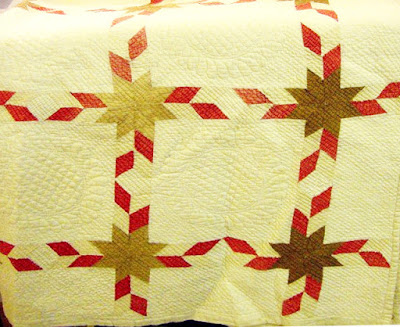BlockBase #3786
First published as Wandering Jew in the 1906 Clara Stone catalog.
Mary Margaret Watson, West Virginia.
Family name for the pattern: Water Witch.
Quilted in the 1940s.
West Virginia project & the Quilt Index.
The Tennessee project documented this variation of the pattern
dating to 1840-1860. The block is plain white with an applique bouquet.
The star pattern is in the sashing.
Quilt from the Barker family, Montgomery County, Tennessee
Stone showed two variations of this star pattern
Quilt in the pattern dated 1889
The blocks are unpieced blue calicoes, the sashing is
made of pink and white diamonds with a blue square on point.
You get the same pattern if you eliminate the box from Stone's
drawing and repeat the blocks.
Late-19th-century quilt
Leaving you a good spot for some fancy quilting with no seams to quilt across.
Turkey red and white version by Lena Glasser, Butler County, Iowa
from the Iowa Project and the Quilt Index.
You could set the blocks and sashing on the diagonal as Lena did
or on the square.
Here's a variation that looks to be about 1890-1920.
The 1930s or '40s
When Eveline Foland drew the pattern for the Kansas City Star in 1929 she knew how to picture it. I wouldn't be surprised to find that she had a copy of Stone's catalog. Stone inspired many quilts between 1895 and 1925 and then many quilt pattern designers thereafter. Cupid's Arrow Point didn't inspire many quilters however. Foland didn't seem to understand that those pink V shaped pieces at the top of the pattern were absurd.
"Clip seam" indeed.
Someone followed Foland's pattern.
Hall's block and sashing (she calls it a border) in the collection
of the Spencer Museum of Art at the University of Kansas
Carrie Hall included her version of Cupid's Arrowpoint in her book Romance of the Patchwork Quilt in 1935, explaining how to set it as "an all-over pattern a bit different from the usual patchwork, since the center patch is white and the interest is in the border around it." She used the same V-shaped piece Foland pictured.
The star in a conventional block version was often made.
Last quarter 19th century,
By Ella Shelton Perry, Tennessee Project & the Quilt Index
Collector purchased in Florida or Georgia. West Virginia
project and the Quilt Index. Maybe the 1940s
Similar look from an online auction
You can keep adding diamonds.
Block style quilt by Elizabeth Jane Hoke with more diamonds,
from about 1890-1920 documented in the West Virginia project.
Family name for the pattern was Cross.
Is this what Clara meant?
Like Nancy Cabot and Aunt Martha---Clara A. Stone was a pen name,
Wilene Smith tells me. There was no real Clara A. Stone. Too bad, I had
a mental picture of her in her Boston home with some graph paper and
a bottle of India ink.




























Seams like that "clipped seam" on the V block are sometimes used to make a point in dressmaking but it's pretty hard to get them to look right. I would say that "clip" would be fine for applique but probably the intention of the designer was a sewn seam. I've actually read older books on quilts that have patterns in the back that give instructions for piecing using lots of clipped seams derived from dressmaking techniques. To sew the quilt patches that way would be a lot more work than necessary and also the end product might not look that good. I'm sure those instructions came from someone who had some sewing experoence but who had never made a quilt and who thought they were quite appropriate.
ReplyDeleteNot so ridiculous, that clipped seam. You treat it like a set-in seam. Sew the first half, stop and reinforce. Clip the seam. Sew the second half, stopping and reinforcing. I've done it in quite a few blocks now (Maltese star type block, one of the Chimney Swallow type blocks, etc) and it looks fine and while it's not for beginners, it's pretty easy.
ReplyDelete